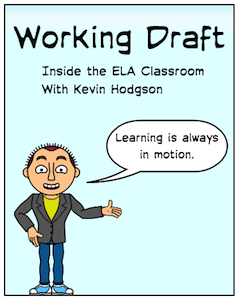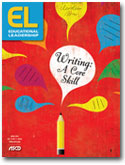9 Notes to the Writers in Ed Leadership Magazine
A MiddleWeb Blog

For April 2014, Educational Leadership magazine’s theme of the month was all about writing and its importance in the Common Core era. I read through the articles, which really got me thinking about the continuing relevance and power of writing. So much so that I found myself wishing I could engage the folks who wrote the pieces in a conversation.

This difficulty in commenting is a bit frustrating in the digital age, where we have some expectation that we can have at least a quick dialogue around professional articles we read and wonder about. Who wouldn’t want to ask Penny Kittle a question about her work around writing about reading? I’d love to pick the brain of Mary Ehrenworth about how to get parents on board as partners in the teaching of writing. And Carol Jago’s wealth of knowledge of writing is something to be further explored. Or I might add to Jeff Anderson’s list of what is and what isn’t writing.
Commenting: My Plan B
Since I could not react directly to the articles and their authors, I decided to go another route. On the last page of Educational Leadership’s Writing: A Core Skill edition, there is an infographic of sorts called “Nine Notes About Writing,” where the editors have plucked out quotes from nine selected articles. It’s a nice way to bring to the surface some main ideas, and I decided it would be the perfect place to write my own responses to the featured authors.
I downloaded the graphic from Educational Leadership, and moved it into ThingLink, a handy site/app that allows you to layer text and media. For each of the nine takeaways, I wrote a short letter to the author, reflecting on what they wrote and pondering some ideas. It’s not a perfect way to engage in conversation but I felt better afterwards, knowing my ideas were blending with (or at least sitting alongside) theirs. Below, you can tap/mouse over any tile and click the red/white circle to see my letter.)
Let’s talk among ourselves . . .
What are your thoughts on writing? How is writing changing in the age of technology? What skills do you see as most important? How do you engage your students in meaningful ways? Leave a note in the comment section of this blog and let us know. We always appreciate a good conversation about learning here at MiddleWeb.




































Great Idea, Kevin I share your frustration with the relative impenetrability of “accessible” sources. The infographic plucks some good lines – some almost truisms from recent scholarship on teaching writing, so not new. As a starting point here, I’ll tap Heather’s statement about “empathy – counterargument” and contend that writing, increasingly through the grades and into college, remains too preoccupied with argument, perhaps in part in service to an argumentative, often polarized culture. Genuine concern with empathy might suggest shifting away from that preoccupation into consideration of issues, especially public issues, in far more nuanced ways than pro-con, point-counterpoint. As our political science curricula generate majors who feed the hidden tier of policy makers behind elected officials, our treatment of rhetoric too often feeds the bombast of Sunday morning television, its audience, and a population that often behaves the same way without even attending to “news & commentary.” So, let’s pursue approaches to writing “for living” (Kittle) with deeper empathy and evident civility?
Three cheers for empathy as the core of our writing. While I, too, am a bit uncomfortable with the prominent shift into argument, I also see the value and understand a bit about how our focus (at least in elementary) almost entirely on narrative was itself a bit off balanced. The fear is always that the drift goes too far. We don’t want our classrooms to be a place where only arguments get hashed out, at the expense of creativity.
True… although at the elementary level I’m hardly worried about narrative imbalance when by the time I see students in college I would love for them to value writing at all. Of greater concern to me is the line of thinking which so privileges argument as the epitome of rhetoric when our society so needs nuanced understanding, empathetic understanding, and civil public discourse.
While I do appreciate all of the views on reading and writing you shared, I especially love how you modeled a great use for ThingLink which made me think more about how I could use this technology in the classroom to further interactions about content in social studies. Thanks so much!
You are most welcome, Holly. The application certainly has some possibilities for annotating text and images, and I believe there is an educational account that one can get via Thinglink (I seem to remember they were giving them out for free at the start of the year). But now, I can’t find any active links about it.